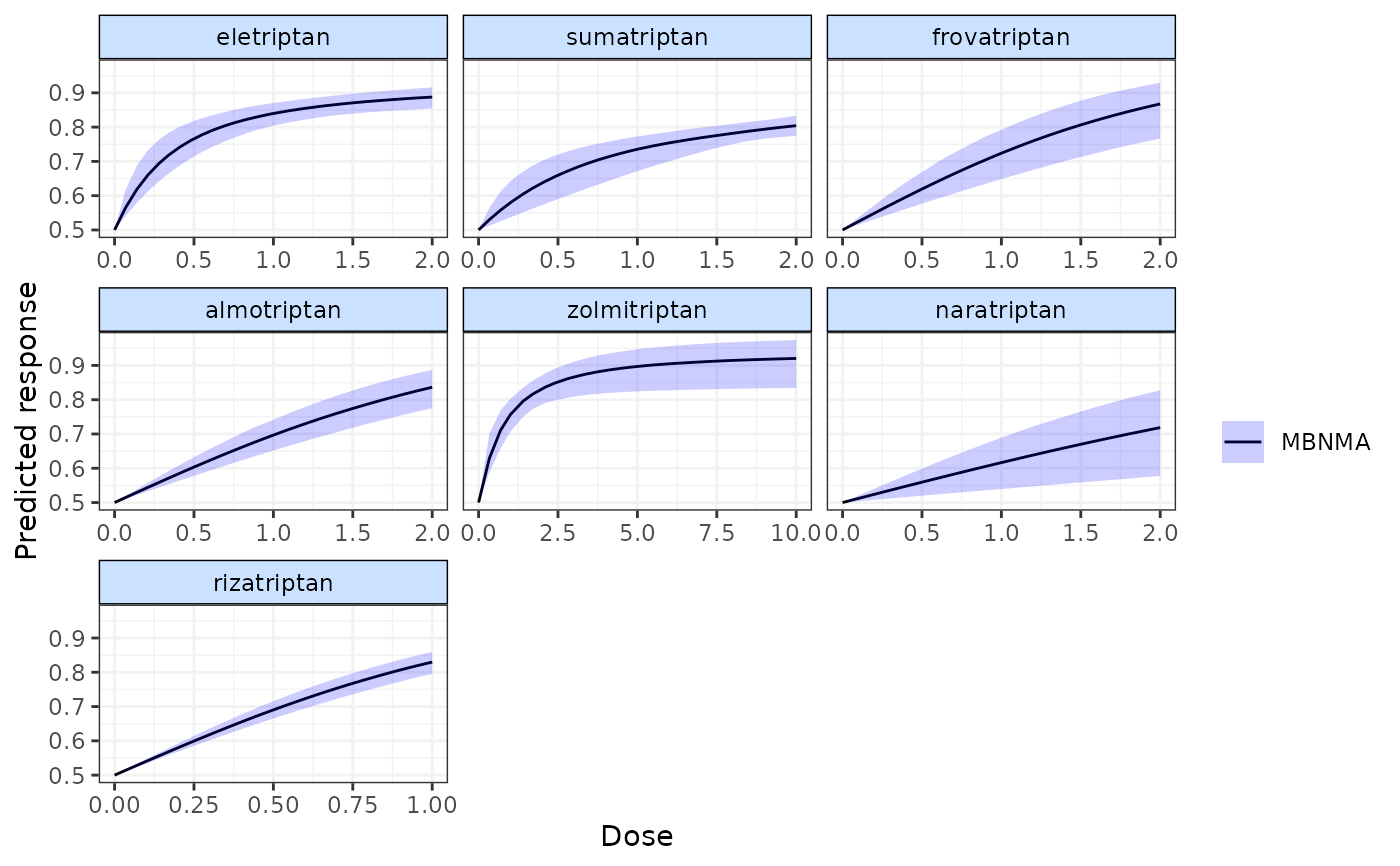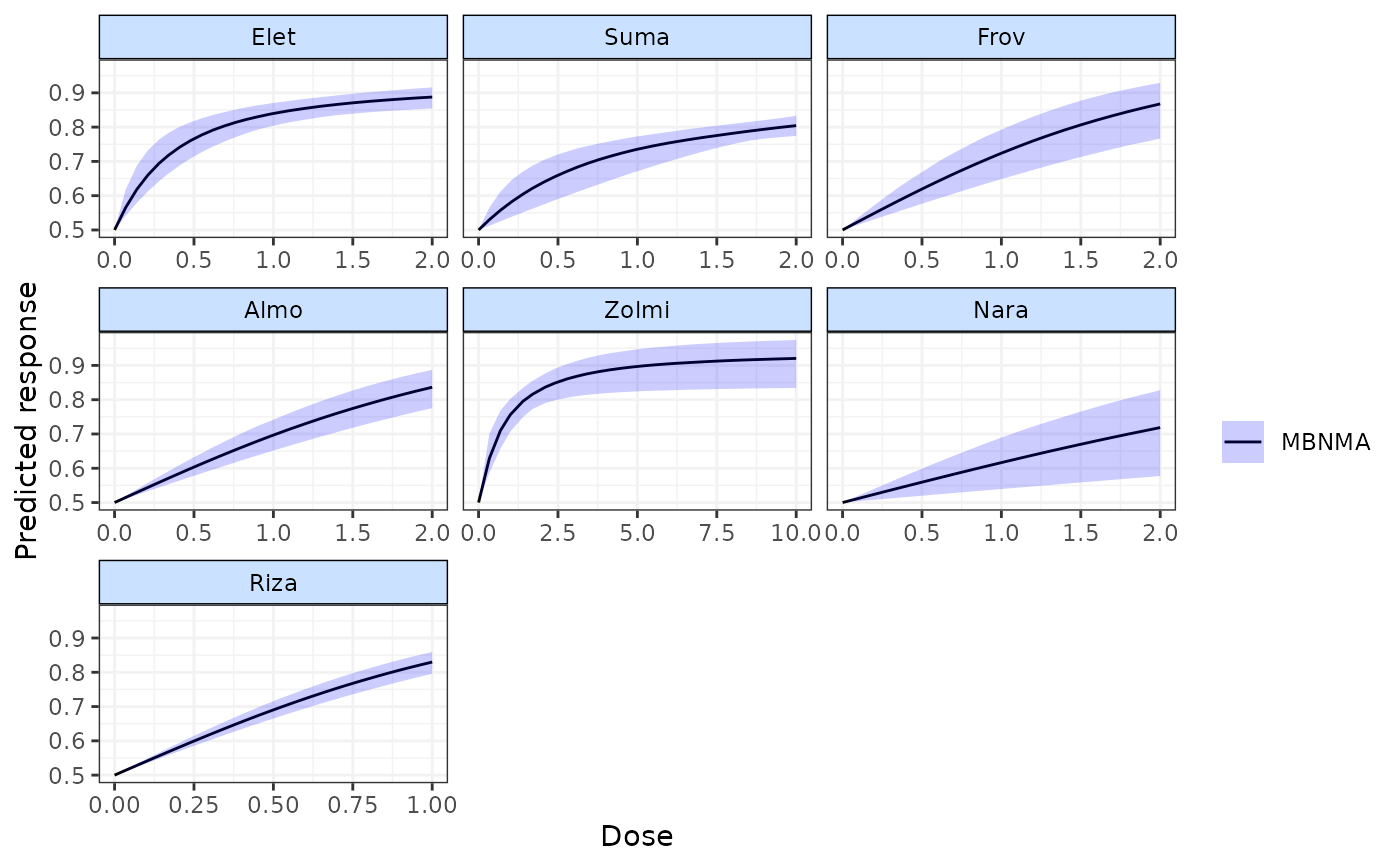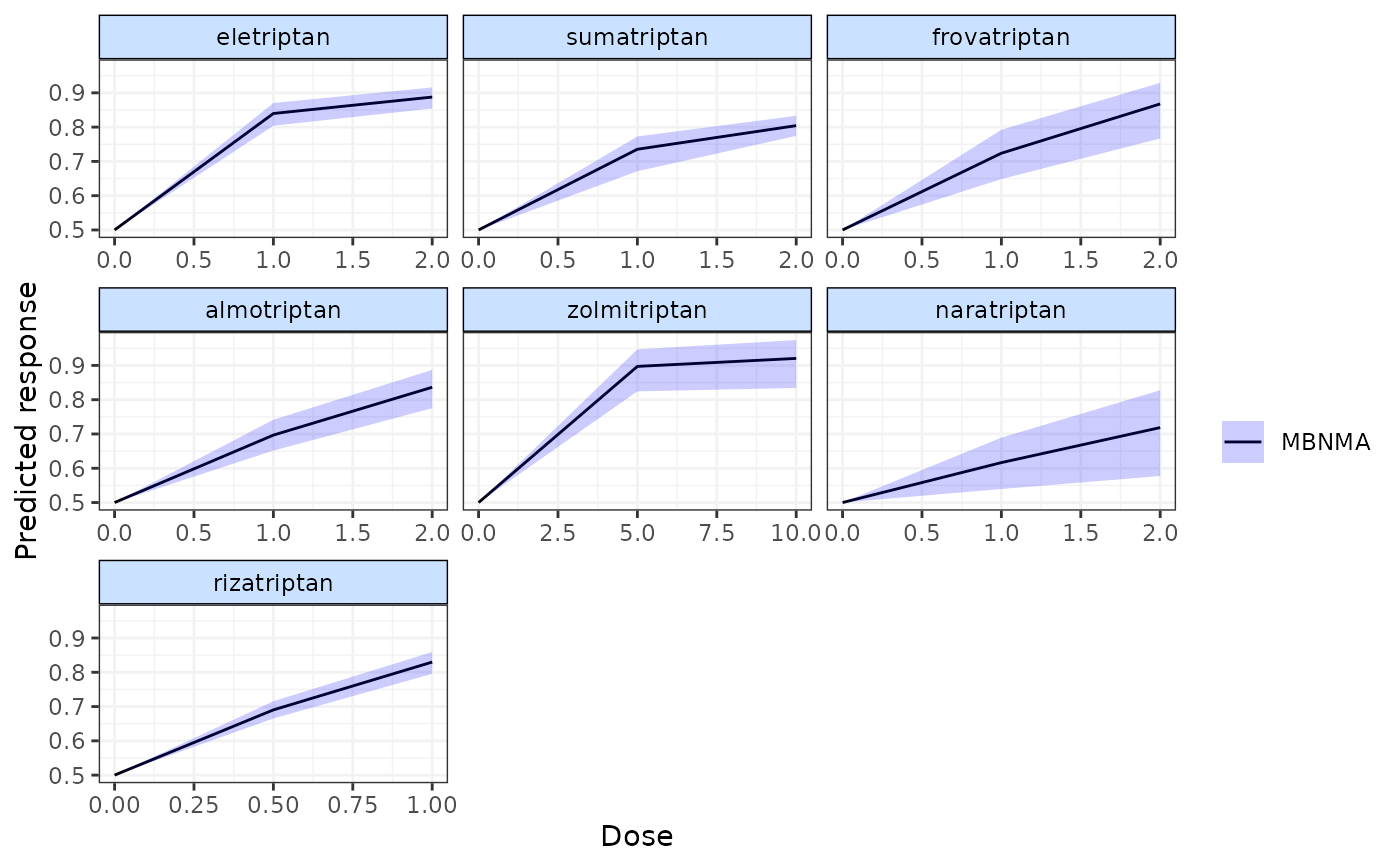Plots predicted responses from a dose-response MBNMA model
plot.mbnma.predict.RdPlots predicted responses on the natural scale from a dose-response MBNMA model.
# S3 method for class 'mbnma.predict'
plot(
x,
disp.obs = FALSE,
overlay.split = FALSE,
method = "common",
agent.labs = NULL,
scales = "free_x",
...
)Arguments
- x
An object of class
"mbnma.predict"generated bypredict("mbnma")- disp.obs
A boolean object to indicate whether to show the location of observed doses in the data on the 95\% credible intervals of the predicted dose-response curves as shaded regions (
TRUE) or not (FALSE). If set toTRUEthe original network object used for the model must be specified innetwork.- overlay.split
A boolean object indicating whether to overlay a line showing the split (treatment-level) NMA results on the plot (
TRUE) or not (FALSE). This will require automatic running of a split NMA model. Foroverlay.split=TRUEthe original network object used for the model must be specified innetwork.- method
Indicates the type of split (treatment-level) NMA to perform when
overlay.split=TRUE. Can take either"common"or"random".- agent.labs
A character vector of agent labels to display on plots. If left as
NULL(the default) the names of agents will be taken frompredict. The position of each label corresponds to each element ofpredict. The number of labels must equal the number of active agents inpredict. If placebo / dose=0 data is included in the predictions then a label for placebo should not be included inagent.labs. It will not be shown in the final plot since placebo is the point within each plot at which dose = 0 (rather than a separate agent).- scales
Should scales be fixed (
"fixed", the default), free ("free"), or free in one dimension ("free_x","free_y")?- ...
Arguments for
ggplot2
Details
For the S3 method plot(), it is advisable to ensure predictions in
predict are estimated using a sufficient number of doses to ensure a smooth
predicted dose-response curve. If disp.obs = TRUE it is
advisable to ensure predictions in predict are estimated using an even
sequence of time points to avoid misrepresentation of shaded densities.
Examples
# \donttest{
# Using the triptans data
network <- mbnma.network(triptans)
#> Values for `agent` with dose = 0 have been recoded to `Placebo`
#> agent is being recoded to enforce sequential numbering
# Run an Emax dose-response MBNMA and predict responses
emax <- mbnma.run(network, fun=demax(), method="random")
#> `likelihood` not given by user - set to `binomial` based on data provided
#> `link` not given by user - set to `logit` based on assigned value for `likelihood`
#> Compiling model graph
#> Resolving undeclared variables
#> Allocating nodes
#> Graph information:
#> Observed stochastic nodes: 182
#> Unobserved stochastic nodes: 197
#> Total graph size: 4115
#>
#> Initializing model
#>
pred <- predict(emax, E0 = 0.5)
plot(pred)
 # Display observed doses on the plot
plot(pred, disp.obs=TRUE)
#> 66 placebo arms in the dataset are not shown within the plots
#> Warning: No shared levels found between `names(values)` of the manual scale and the
#> data's fill values.
# Display observed doses on the plot
plot(pred, disp.obs=TRUE)
#> 66 placebo arms in the dataset are not shown within the plots
#> Warning: No shared levels found between `names(values)` of the manual scale and the
#> data's fill values.
 # Display split NMA results on the plot
plot(pred, overlay.split=TRUE)
#> Compiling model graph
#> Resolving undeclared variables
#> Allocating nodes
#> Graph information:
#> Observed stochastic nodes: 182
#> Unobserved stochastic nodes: 92
#> Total graph size: 3436
#>
#> Initializing model
#>
#> Split NMA residual Deviance: 267.2
#>
# Display split NMA results on the plot
plot(pred, overlay.split=TRUE)
#> Compiling model graph
#> Resolving undeclared variables
#> Allocating nodes
#> Graph information:
#> Observed stochastic nodes: 182
#> Unobserved stochastic nodes: 92
#> Total graph size: 3436
#>
#> Initializing model
#>
#> Split NMA residual Deviance: 267.2
#>
 # Split NMA results estimated using random treatment effects model
plot(pred, overlay.split=TRUE, method="random")
#> Compiling model graph
#> Resolving undeclared variables
#> Allocating nodes
#> Graph information:
#> Observed stochastic nodes: 182
#> Unobserved stochastic nodes: 205
#> Total graph size: 3979
#>
#> Initializing model
#>
#> Split NMA residual Deviance: 189
#> Split NMA between-study SD: 0.27 (0.182, 0.368)
#>
# Split NMA results estimated using random treatment effects model
plot(pred, overlay.split=TRUE, method="random")
#> Compiling model graph
#> Resolving undeclared variables
#> Allocating nodes
#> Graph information:
#> Observed stochastic nodes: 182
#> Unobserved stochastic nodes: 205
#> Total graph size: 3979
#>
#> Initializing model
#>
#> Split NMA residual Deviance: 189
#> Split NMA between-study SD: 0.27 (0.182, 0.368)
#>
 # Add agent labels
plot(pred, agent.labs=c("Elet", "Suma", "Frov", "Almo", "Zolmi",
"Nara", "Riza"))
# Add agent labels
plot(pred, agent.labs=c("Elet", "Suma", "Frov", "Almo", "Zolmi",
"Nara", "Riza"))
 # These labels will throw an error because "Placebo" is included in agent.labs when
#it will not be plotted as a separate panel
#### ERROR ####
#plot(pred, agent.labs=c("Placebo", "Elet", "Suma", "Frov", "Almo", "Zolmi",
# "Nara", "Riza"))
# If insufficient predictions are made across dose-response function
# then the plotted responses are less smooth and can be misleading
pred <- predict(emax, E0 = 0.5, n.doses=3)
plot(pred)
# These labels will throw an error because "Placebo" is included in agent.labs when
#it will not be plotted as a separate panel
#### ERROR ####
#plot(pred, agent.labs=c("Placebo", "Elet", "Suma", "Frov", "Almo", "Zolmi",
# "Nara", "Riza"))
# If insufficient predictions are made across dose-response function
# then the plotted responses are less smooth and can be misleading
pred <- predict(emax, E0 = 0.5, n.doses=3)
plot(pred)
 # }
# }